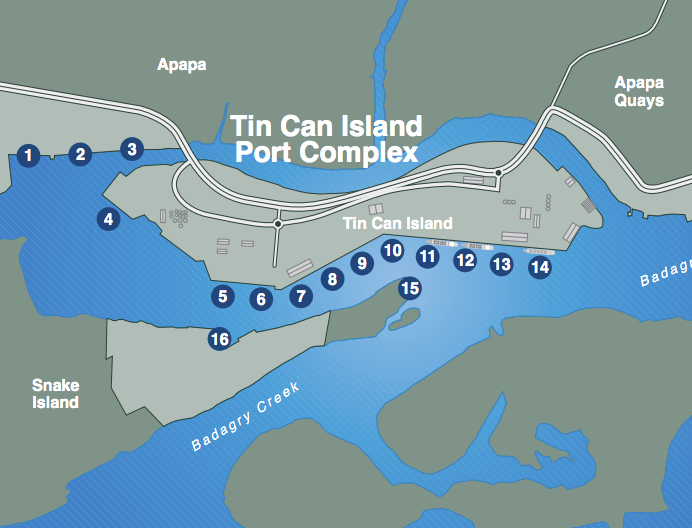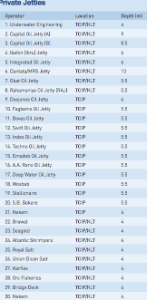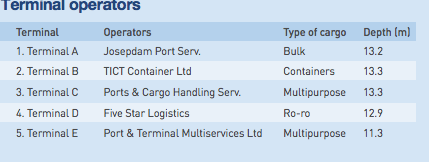- Port Overview
- Port Picture
- Description and Contacts of Key Companies
- Port Performance
- Discharge Rates and Terminal Handling Charges
- Berthing Specifications
- General Cargo Handling Berths
- Port Handling Equipment
- Container Facilities
- Customs Guidance
- Terminal Information
- Stevedoring
- Hinterland Information
- Port Security
Port Overview
Tin Can Island Port is the second busiest Port in Nigeria after Apapa Port. The port handles diversified cargoes with each terminal operator specializing in different forms of cargo (Dry and Wet bulk cargoes, Box-Containerized cargoes, RORO services). The port handles vessels ranging from 100m – 260m. It is well-equipped and up to date with modern equipment for clearing cargoes.
It provides water supply and bunkering and 24 hours pilotage service.
Private terminal operators operate all terminals and average berth occupancy rate is 83% as at 2018.
The facilities can handle ships of about 30,000 tonnes.
Tin Can Port is well equipped with modern cargo handling equipment and personnel support facilities. It has intermodal connection – water and road, however road transport is by far the dominant method. This results in bottlenecks caused by traffic gridlock due to the large numbers of trucks entering and exiting the port facilities and parked on access roads waiting call up.
Military and paramilitary checkpoints are present in front of the ports and environs.
Port website: http://nigerianports.gov.ng/tincan/
- Josepdam Terminal: http://www.jps.ng/
- Ports & Cargo Terminal: http://sifaxgroup.com/company/ports-and-cargo/
- Five Star Terminal: http://www.fivestarlogisticsltd.com/
- Ports and Terminal Multiservice Ltd: http://www.ptml-nigeria.com/index.html
Key port information may also be found at: https://www.maritime-database.com/
|
Port Location and Contact |
|
|
Country |
Nigeria |
|
Province or District |
Lagos |
|
Nearest Town or City with Distance from Port |
Lagos 7 Km |
|
Port's Complete Name |
Tin Can Island Port |
|
Latitude |
06°25.7’N |
|
Longitude |
003°20.53E |
|
Managing Company or Port Authority
|
Terminal A Josepdam Port Serv. www.jps.ng Terminal B TICT Container Ltd www.tict-ng.com Terminal C Ports & Cargo Handling Serv. www.sifaxgroup.com Terminal D Five Star Logistics www.fivestarlogisticsltd.com Terminal E Port & Terminal Ltd www.ptml-nigeria.com |
|
Management Contact Person |
Terminal A: Josepdam Port Serv. Mr. Sunday Aindero / 08037241211 / saindero@jps.ng
Terminal B: TICT Container Ltd Yann Magarian
Terminal C: Ports & Cargo Handling Serv. Mr. John Jenkins/08102852900/ johnje@sifaxgroup.com
Terminal D: Five Star Logistics Mr. Wolfgang Schneider / 08090401287 / wolfgang.schneider@5starterminal.com
Terminal E: Ports and Terminals Multiservices Ltd. www.ptml-nigeria.com |
|
Nearest Airport and Airlines with Frequent International Arrivals/Departures |
Lagos Murtala Muhammed International Airport Arik Air, ASKY, British Airways, Delta Airlines, Egypt Air, Emirates, Ethiopian Airlines, Etihad Airways, KLM, Lufthansa, Middle East Airways, Qatar Airways, Virgin Atlantic Airways |
Port Picture




Description and Contacts of Key Companies
Under the NPA concession scheme the following operators are responsible for the management, maintenance and operations of one each of the 5 terminals.
Terminal services offered are bulk, containers, multipurpose and Ro-ro
The terminal operators are:
- Josepdam Port Services,
- TICT Container Ltd,
- Ports & Cargo Handling Services,
- Five Star Logistics,
- Port & Terminal Multiservice Ltd
For more information on port contacts, please see the following link: 4.4 Nigeria Port and Waterways Company Contact List
Port Performance
Tin Can Island has 5 terminals with varying areas of specialty.
- Terminal A is predominantly a breakbulk terminal,
- Terminal B a core container terminal,
- Terminal C, D & E are conventional terminals (containerized, break bulk & RORO).
The draft of the Tin Can channel is 15 metres while draft alongside the terminals range 12.5 - 13 metres and may be unsuitable for ocean going vessels requiring more drafts.
Terminal berths are fully optimized however port is congested due to slower than optimum turnaround times. Major bottleneck also occurs as a result of the truck congestion to and from the port complexes. This is now being addressed using holding bays and progress/impact is being monitored. Average waiting time at Tin Can is 2.5 days.
Cumulative cargo handling capacity of Tin Can (incl. container volume) in 2017 was 15,520,925 MT.
|
Seasonal Constraints |
||
|
|
Occurs |
Time Frame |
|
Rainy Season |
Yes |
From April to September |
|
Major Import Campaigns |
Yes |
From October to March |
|
Other Comments |
The peak months of the rainy season is between the months of July & August. The major import periods precede the end of year festivities for Nigeria and its major trading partners (Chinese New Year) |
|
|
Handling Figures for 2017 |
|
|
Vessel Calls |
1,350 vessels |
|
Container Traffic (TEUs) |
862,273 |
|
Handling Figures Bulk and Break Bulk for 2017 |
|
|
Bulk (MT) |
15,521,000 |
|
Break bulk (MT) |
27,000,000 |
Discharge Rates and Terminal Handling Charges
For information on port rates and charges, please see the following links to the websites of the terminal management companies:
Josepdam Port services: https://www.jps.ng/
Ports & Cargo: http://sifaxgroup.com/companies/ports-and-cargo-handling-services-limited/
PTML: https://billing.grimaldi-nigeria.com/
TICT: https://www.tict-ng.com/
Five Star Logistic: http://www.fivestarlogisticsltd.com/
Berthing Specifications
|
Type of Berth |
Quantity |
Length (m) |
Maximum Draft (m) |
Comments |
|
Conventional Berth |
50+ |
N/A |
12.5m |
There is no specific LOA allocated for conventional berths |
|
Container Berth |
100+ |
2072m |
12.5m |
- |
|
General Berth |
50 |
|
|
|
|
RoRo Berth |
1 |
485 |
|
|
|
Silo Berth |
20 |
484m |
12.5m |
Silos are privately owned but available for 3rd party lease |
|
Berthing Tugs |
20+ |
50m |
- |
Tug boats are allocated to vessels by the Nigeria Port Authorities |
|
Water Barges |
60+ |
40m |
- |
Container barges are privately owned and operated. RORO barge available is owned and operated by PTML terminal |
The total LOA for all terminals in
Tin Can is 2,980m and with an average
draft of 12.5 meter.
General Cargo Handling Berths
|
Cargo Type |
Berth Identification |
|
Imports - Bagged Cargo |
1, 1A, 2 & 12 (Joseph dam & Five star) |
|
Exports - Bagged Cargo |
1, 1A, 2 & 12 (Joseph dam & Five star) |
|
Imports and Exports - RoRo |
8,9 & 12 (Grimaldi / PTML) |
|
Other Imports |
Steel coils, Hardboards, paper reels etc |
Port Handling Equipment
The respective terminals are all concessional leases by the government to private businesses who now operate and manage the port facilities and in turn pay royalties to the government for the period of concession.
|
Equipment |
Available |
Total Quantity and Capacity Available |
Comments on Current Condition and Actual Usage |
|
Dockside Crane |
Yes |
Sufficient for demand |
Terminal B & C are both fitted with RTG gantry and mobile cranes respectively. |
|
Container Gantries |
Yes |
Sufficient for demand |
Available in Terminal B & C |
|
Mobile Cranes |
Yes |
Sufficient for demand |
Available in Terminal B, C, D & E |
|
Reachstacker |
Yes |
Sufficient for demand |
Available at all terminals |
|
RoRo Tugmaster (with Trailer) |
Yes |
Sufficient for demand |
Available at select terminals |
|
Grain Elevator with Bagging Machines |
Yes |
Sufficient for demand |
Available upon request and for a fee as this is not terminal owned |
|
Transtainer |
Yes |
Sufficient for demand |
Available at select terminals |
|
Forklifts |
Yes |
Sufficient for demand |
Available at all terminals |
Container Facilities
|
Facilities |
20 ft |
40 ft |
|
Container Facilities Available |
Forklifts, Reach stackers, Mobile cranes, RTG Gantry cranes |
|
|
Container Freight Station (CFS) |
Yes |
Yes |
|
Refrigerated Container Stations |
Yes |
Yes |
|
Number of Reefer Stations
|
500+ |
|
|
Other Capacity Details |
Upon periods of terminal congestion, units are transferred to off-dock locations for pick up. |
|
|
Daily Take Off Capacity
|
There are no delays as a result of offloading capacity. Container unloading facilities are efficient. |
|
|
Number of Reefer Stations
|
Terminal A: Nil Terminal B: 200 Terminal C: 102 Terminal D: TBC Terminal E: TBC
|
Terminal A: Nil Terminal B: 200 Terminal C: 102 Terminal D: TBC Terminal E: TBC |
|
Emergency Take-off Capacity |
There are no delays as a result of offloading capacity. Container unloading facilities are efficient. |
|
|
Off take Capacity of Gang
Shift
|
There are no delays as a result of offloading capacity. Container unloading facilities are efficient.
|
|
Customs Guidance
The Nigerian customs has functions which includes but is not limited to the following: Collection of revenue (Import /Excise Duties & other Taxes /Levies) and accounting for same; anti-smuggling activities; security functions; generating statistics for planning and Budgetary purposes; monitoring Foreign Exchange utilisation, etc; engaging in Research, Planning and Enforcement of Fiscal Policies of Government; manifest processing; licensing and registration of Customs Agents; registration and designation of collecting banks; and working in collaboration with other government agencies in all approved ports and border station. Customs offices are located within and outside the port complex.
There are 3 units; inspection, clearing and gate control.
Hours are weekdays between 1000 to 1600 for clearing and 1000-2000 hours for release. Clearing and release officers do not operate weekends or public holidays and may be more difficult to engage on Fridays. Customs Gate Exit officers are on duty 24/7
For more information on customs in Nigeria, please see the following link: 1.3 Nigeria Customs Information
Terminal Information
Multipurpose terminal
There are multiple multipurpose terminals available they have all necessary facilities (handling equipment, space, storage etc) available.
Terminal D & E are multipurpose terminals which caters to both containerized and general cargo vessels.
Terminal D has 1 dedicated berth to RORO vessels with terminal capacity to hold 5000 vehicles at a time. Warehouse facility available is 6,300 m2.
Terminal E has 2 berths available for RORO or container vessels. Vehicle holding area of terminal is 230,000 m2 and this is including holding facility outside the port complex but is fed using barges. Warehouse facility available is 3,500 m2.
Grain and bulk handling
Only the Josepdam terminal (Terminal A) is fitted with suckers for handling grain and bulk shipment. These suckers take up grains from vessels alongside and into Silos. The storage capacity of the silos is 28,000 MT of grain. Suckers are owned but owned by a private business using same for its products/vessels. These suckers are available for lease if required.
The terminal handles wheat, maize and malt and can take delivery of about 4000 MT of grain daily. The facilities can handle ships of about 30,000 tonnes. There is also a grain bagging facility on-site which is transported by Fleetwood Transportation.
Main storage terminal
There is sufficient current warehouse space for food stores, bagged and general cargo however not all facilities are totally secure. This should be checked with clearing agents.
Terminal A, D & E all have 1 warehouse facilities each within the terminal. However only Terminal A allows cargo storage in the open stack area.
|
Storage Type |
Number of Storage Facilities |
Area (m2) |
|
Bagged Cargo |
3 terminal warehouse facilities |
18,574 |
|
Refrigerated Cargo |
4 Terminals facilities |
N/A |
|
General Cargo |
1 Terminal open stacking area |
17,000 |
Stevedoring
Stevedoring services are the sole responsibility of the terminal operators. In addition to in-house stevedores, there are several third-party service providers registered with each terminal and the terminal operators nominate stevedoring companies to handle respective vessels. Stevedoring services are adequate and skilled.
Hinterland Information
More than 90% of all import shipments are moved out from the port by road. Goods or containers are loaded on respective trucks for delivery to destination. Truck ownership here is a combination of terminal and third-party vendors. Only a small percentage of cargo is initially moved using barges which haul these shipments to another location within the port city from where they are also eventually loaded onto waiting trucks.
Port Security
All terminal facilities here currently operate on ISPS level 1. There are strict access control mechanisms put in place by each terminal to prevent the entry of un-authorized personnel into the terminal. All authorized persons must conform to international safety standards
|
Security |
|
|
ISPS Compliant |
Yes |
|
Current ISPS Level
|
Level 1 |
|
Police Boats |
Yes |
|
Fire Engines |
Yes |


